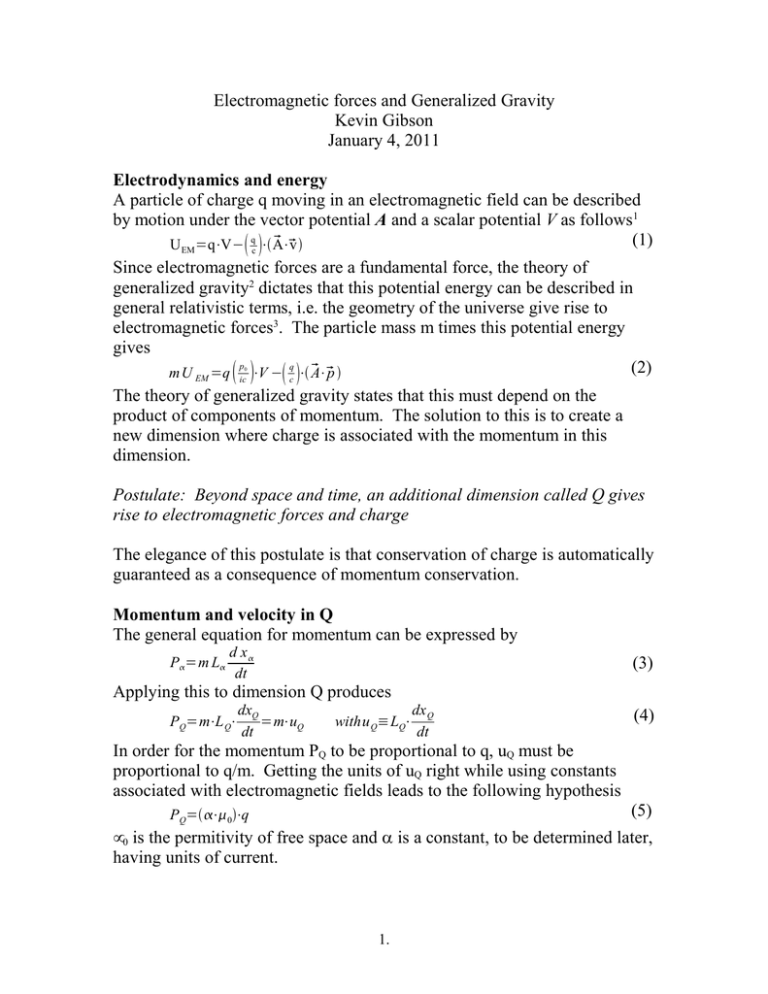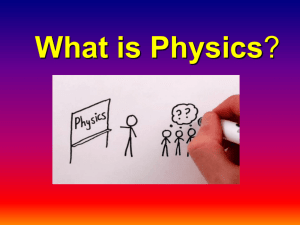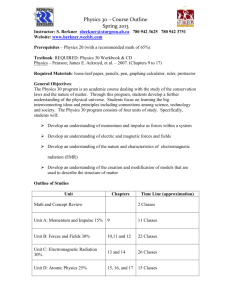Electromagnetic forces and Generalized Gravity Kevin Gibson January 4, 2011
advertisement

Electromagnetic forces and Generalized Gravity Kevin Gibson January 4, 2011 Electrodynamics and energy A particle of charge q moving in an electromagnetic field can be described by motion under the vector potential A and a scalar potential V as follows1 (1) ⋅v U EM =q⋅V− qc ⋅ A Since electromagnetic forces are a fundamental force, the theory of generalized gravity2 dictates that this potential energy can be described in general relativistic terms, i.e. the geometry of the universe give rise to electromagnetic forces3. The particle mass m times this potential energy gives p q (2) mU EM =q ⋅V − ⋅ A⋅p 0 ic c The theory of generalized gravity states that this must depend on the product of components of momentum. The solution to this is to create a new dimension where charge is associated with the momentum in this dimension. Postulate: Beyond space and time, an additional dimension called Q gives rise to electromagnetic forces and charge The elegance of this postulate is that conservation of charge is automatically guaranteed as a consequence of momentum conservation. Momentum and velocity in Q The general equation for momentum can be expressed by P=m L d x dt (3) Applying this to dimension Q produces dx PQ=m⋅L Q⋅ Q =m⋅uQ dt dx withu Q≡LQ⋅ Q dt (4) In order for the momentum PQ to be proportional to q, uQ must be proportional to q/m. Getting the units of uQ right while using constants associated with electromagnetic fields leads to the following hypothesis (5) PQ=⋅0⋅q µ0 is the permitivity of free space and α is a constant, to be determined later, having units of current. 1. Quantizing charge A consequence of introducing Q to explain electromagnetic force is that constraints can be imposed on Q that explain the fact that electric charge comes in units of the electron charge e. If Q is not from -∞ to +∞ but instead is periodic, repeating after a period of lQ, then the eigenstates for the probability amplitude for matter in the Q dimension that maintains a fixed value of momentum in Q would be 2 i⋅nx (6) l Q Q= A⋅e Q Since charge is quantized, the charge on an object would be an integer multiple of e. Obtaining the Q momentum and applying the quantization of charge gives ℏ (7a) ⋅∂Q Q=0 ⋅neQ i LQ LQ⋅l Q= h 0 e (7b) Equation (7b) gives the circumference around Q. If Q has this circumference charge will be quantized in units of e. At this point a word must be said about a choice of Gauge. Equation (2) involves vector and scalar potentials, however what Gauge is to be used? Work on a general treatment of Maxwell's equations4 suggest that fields can act simultaneously through space. This suggests that of the more conventional Gauges the Coulomb Gauge5 may be preferred. Off diagonal values of the scale factors Using the theory of generalized gravity gives the equations (8a) h QQ=LQ h 2Qt = 2LQ ⋅V 0 (8b) h 2Qk = 2LQ ⋅A c 0 k (8c) All other coordinates equal zero. Solving the scale factors remains to be solved once α and LQ are are determined. 2. LQ and α According to General Relativity, matter moves through the Universe in a path described by a Geodesic6. It can be shown that matter with charge q moving in the vicinity of a point charge will have as its geodesic the path described by the coulomb force law given the following condition. (9) ⋅LQ=∣LQ∣ Applying (9) to (7b) as well as (8) means the following can be hypothesized. =1 (10a) LQ=∣LQ∣ (10b) h 2Qt = 2∣LQ∣ V r 0 (10c) h 2Qk = 2∣L Q∣ A r c 0 k (10d) l Q= h 0 e⋅∣LQ∣ (10e) And the momentum is (11) P Q=0⋅q Lastly, borrowing the de Broglie wavelength λQ = h/PQ and insisting that this must equal lQ for the case for a particle of elementary charge e gives |LQ| = 1 from above. So h 2Qt = 2 ⋅V r , t 0 (12a) h 2Qk = 2 ⋅A r c 0 k (12b) h =4.55 nm 0 e (12c) l Q= 3. Quantum Mechanics Applying what is known about the scale factors and momentum to the generalized Klein-Gordon equation7 gives q Ak r ,t E −ℏ 2 2 q V r , t 1 2 ∇ E −∑ p k = E − 0 2m0 E0 E0 2 E0 2 k (13) The tildes signify operators and the E operator is just iħ∂t. The derivation assumed LQ = 1 (as will be shown below). For energy eigenstates with E = E0+ε this becomes q A r , t −ℏ (14) ∇ 2 q Vr , t−∑k pk [q Vr , t − ]= 2 2m0 2 k E0 E0 2 E0 This is the Schrödinger equation with a relativistic correction in brackets. Implications for anti-matter In The Klein-Gordon equation8 it was shown that one could convert a negative energy particle to anti-particle of positive energy by reversing the sign on the momentum 4-vector as well as its charge. In light of the above conclusions one can simplify this rule as follows: One can switch between describing a positive and negative energy particle by reversing the sign on the N-dimensional momentum vector and switch from particle to anti-particle. This may seem on face value to like a restatement of an earlier conclusion. Yet if we expand momentum to a 5-vector to include Q, then this rule automatically covers the switch in charge. Moreover, this rule can serve as a guide to know what quantities have opposite signs between a particle and its anti-particle companion. Conclusion The electromagnetic force on an object can be attributed to the object's geodesic motion in space-time and an additional dimension Q. Assuming that Q is periodic in nature, the quantization of charge can be said to arise from the momentum in this dimension. 4. Works Cited 1. David Griffiths Introduction to Electrodynamics 2nd ed. p. 319-320 2. Kevin Gibson Theory of Generalized Gravity (unpublished) http://www.mc.maricopa.edu/~kevinlg/i256/Generalized_Gravity.pdf 3. http://en.wikipedia.org/wiki/Lorentz_force 4. Kevin Gibson Electrodynamics free from a Gauge choice (unpublished) http://www.mc.maricopa.edu/~kevinlg/i256/maxwell.pdf 5. David Griffiths Introduction to Electrodynamics 2nd ed. p. 317-318 6. http://en.wikipedia.org/wiki/Geodesic_(general_relativity) 7. Kevin Gibson Generalizing the Klein-Gordon equation (unpublished) http://www.mc.maricopa.edu/~kevinlg/i256/Generalized_KG.pdf 8. Kevin Gibson The Klein-Gordon equation (unpublished) http://www.mc.maricopa.edu/~kevinlg/i256/defending_KG.pdf Contact information kevin.gibson@asu.edu 5. kevinlg@mesacc.edu 6.








